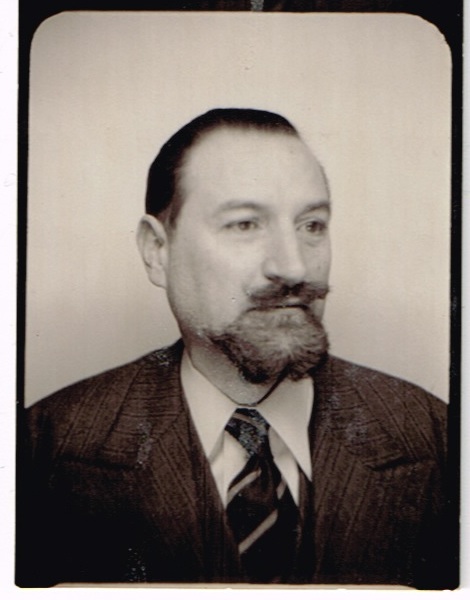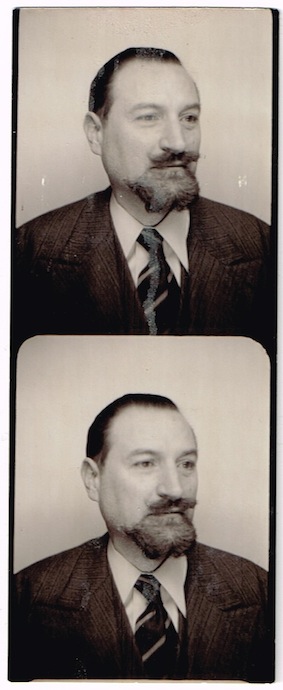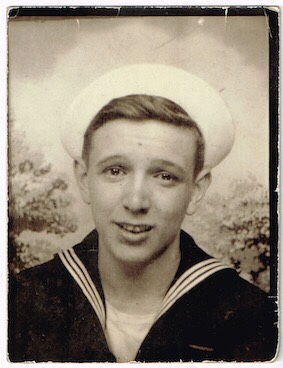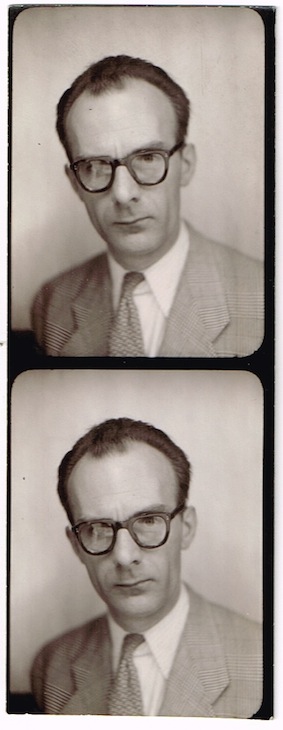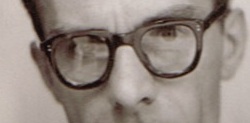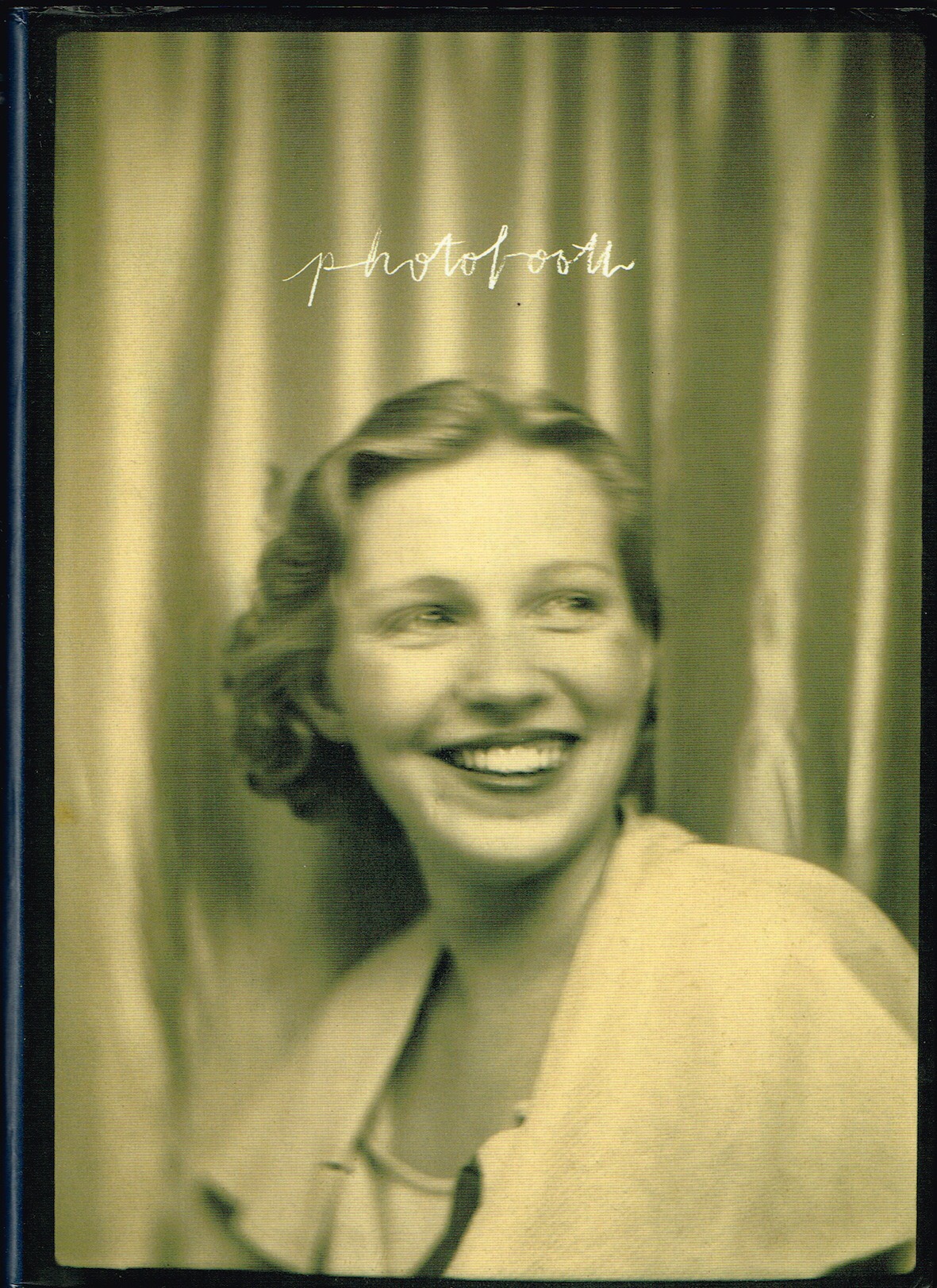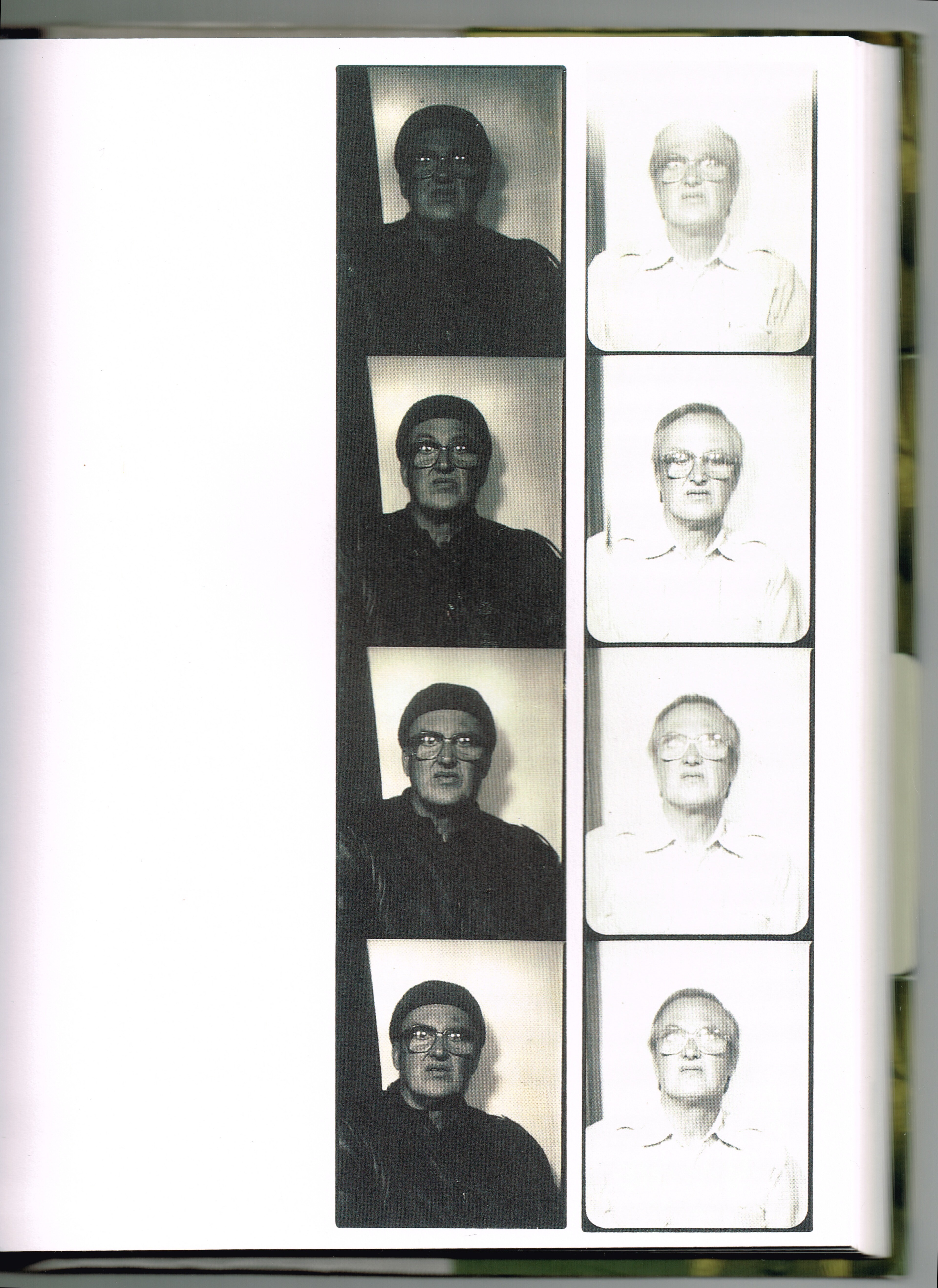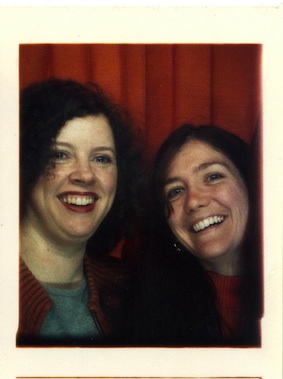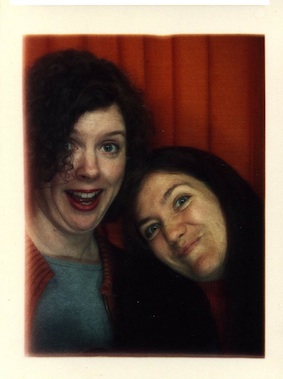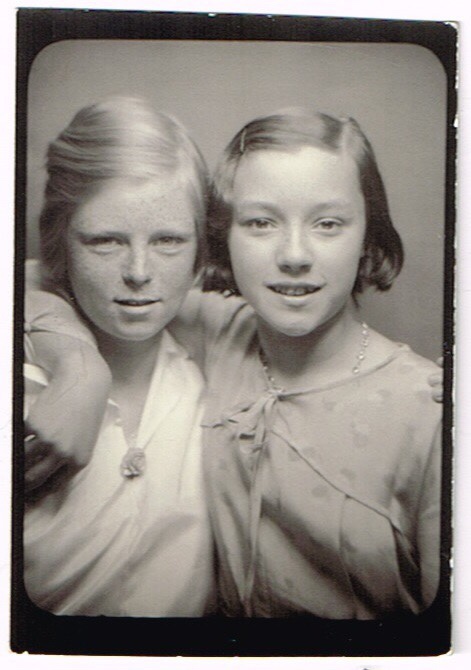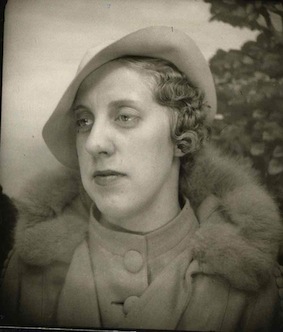
In 2011 I posted a page from a photo album, with a series of booth images, of a woman named Esther. I love the photos in that post! In 2019, writer and blogger Elizabeth Gauffreau loved Esther so much, that she was inspired to write about her. Her story was first published on Open: Journal of Arts and Letters in July this year. It is a beautiful and poignant exploration of what Esther’s life might have been.
Please enjoy reading –
Esther on eBay
2018
Here we find Rodney trolling the antique shops of northern New England. Up and down the Granite State he goes in his shiny black pickup truck with chrome-plated dual exhaust. Rodney is not alone in what he seeks, and competition for buyers on eBay is fierce. Only the stunningly beautiful, the unbearably homely, the deranged, the demented, or the defective will get the attention of eBay buyers forced to be discriminating by indiscriminate sellers.
Today Rodney and his shiny black pickup truck are traveling east on Route 2 into Vermont. He drives right on past any place that looks the least bit upscale, the type of place featuring hulking French armoires that never should have emigrated and spindly chairs that eschew being sat upon. He is after the places that declare themselves antique shops in an effort to mislead, the true nature of their wares being all kinds of weird shit he can’t imagine any sane person ever thinking he could sell: empty Pez dispensers, jars of buttons, dirty crocheted doilies, dusty peacock feathers, dented tea kettles, souvenir shot glasses, stuffed animals with the mange who also have the misfortune to be missing their eyes.
Before long, Rodney comes upon a place that looks promising, a small building with a large overhang and plate glass windows. Annie’s Attic would have been a filling station in the days when Henry Ford offered any color the customer wanted, as long as it was black. Rodney maneuvers his shiny black pickup truck under the overhang and puts it in Park.
He hops down from his truck and goes for the door. When he pushes it open, a shop bell tinkles. He looks this way and that, spots the elderly proprietor seated behind a massive desk sorting receipts. When she looks up, Rodney gives her an upward nod in greeting, playing it cool. The elderly proprietor gives him a downward nod and goes back to her receipts.
Venturing into the shop proper, Rodney finds that the seas of crap he must navigate are heavy indeed: enough vintage bric-a-brac to overrun a small city, stacks of discarded books, cracked leather pocketbooks, antique coffee grinders, vintage egg beaters, misshapen ladies’ hats, rusted tools of no discernible function, and on and on with no horizon in sight.
However, Rodney is resolute. With the thoroughness of a tax auditor, he systematically examines one assemblage of crap and moves onto the next until at last he finds what he’s been looking for. On the bottom shelf of a bookcase next to a stack of Life magazines featuring outed Hollywood heartthrobs of yesteryear is a pile of antique photographs, each in its own protective sleeve with a wee price tag affixed to it.
Rodney begins his examination of the photographs, assessing each one for its eBay potential. He quickly sets aside the generic Victorian infants in fussy white dresses staring despondently at the camera and their equally despondent older selves. He also rejects the usual parade of portly Victorian gentlemen, some mustachioed, some bewhiskered, all smug. Unless one comes with a newspaper provenance as a serial killer of some kind, these gentlemen generate no interest. Into the “no” pile go the anonymous bridal parties and the great-great-grannies with no teeth slumped in front of derelict homesteads. Rodney holds back a few of the larger photographs, groups of defiant school children, multigenerational families with receding chins, but upon closer examination, these won’t fit the bill either. It’s time to move on.
As Rodney begins making his way back to the entrance of Annie’s Attic, he spies what looks like a slim black photograph album on a table piled with costume jewelry. When he opens the album, looking up at him coquettishly is a middle-aged woman in a veiled hat. She is unbearably homely. On the inside cover of the album in white ink is a name and a year: Esther Nusbaum, 1937. Rodney slowly turns the pages of the album. Centered on each page is a different photograph of the same woman. She is unbearably homely, she is making a damned fool of herself, and she has a name. Rodney will sell Esther on eBay.
1937
Esther shelves the last of the abandoned books: novels unfairly judged by their covers, a local history with print too fine for fading eyes, Encyclopedias Britannica scattered by careless school children. It is time to go home. She puts on her coat and hat, takes one last look around the reading room, and turns out the lights. She has a casserole to get to. She locks the front door and hurries down the broad granite steps to the street. She has a casserole to get to, a table to set, a dinner to eat in watchful, hopeful silence.
Esther doesn’t mind the long walk home from the library; in fact, she rather enjoys it. When she stops at the post office to collect the afternoon mail, the postmaster always speaks to her, calling out a personal comment about the family’s mail in a preview of coming attractions from behind the counter. Invariably, someone stops her on Main Street to ask if his interlibrary loan has arrived. Esther can walk home confident in the knowledge that anyone she meets on the sidewalk will greet her by name or, if out of earshot, wave a greeting instead.
She smells the casserole as soon as she enters the house. The boys have put it in the oven as instructed. She calls up the stairwell, “I’m home, boys!” but receives no response. After taking off her coat and hat, she calls up the stairwell once again, “I’m home, boys!” but again receives no response.
She goes into the dining room and takes a clean tablecloth from the buffet. The best part of setting a table has to be shaking out the folds of a clean tablecloth and floating it over the table. Suspended for the briefest of moments, will the tablecloth settle with a minimum of adjustment and fuss? Her best tablecloths are heavy enough to fall and settle of their own accord, but the everyday ones have a tendency to skitter and slide and not know when to stop. But Esther doesn’t mind. There is a hierarchy of tablecloths, and she respects it.
She leans over the tablecloth to smooth out the wrinkles, adjusting the low side higher and the high side lower. Jim will be home soon. She goes into the kitchen and takes the casserole out of the oven. On days she works at the library, she has to rely on casseroles, which does occasionally give her pause. Just as there is a hierarchy of tablecloths, there is a hierarchy of evening meals. A casserole ranks higher than a cold plate, but far below a roast or even cube steak. Esther knows this. She also knows that there is no vast recipe library extant to provide for an infinite variety of casseroles, so she relies on cheese, hot, bubbling, nicely-browned cheese, to get her through.
Esther is still setting the table when Jim’s car pulls into the drive. She hears him enter the house and drop his keys on the stand in the front hall. “I’m in the dining room, Jim!” she calls, but he doesn’t answer. He washes his hands at the kitchen sink, she calls the boys to come to the table, and they all sit down to eat.
No one speaks to Esther at the table, not even to direct the serving of his portion. Each takes his plate from her in turn, picks up his fork, and proceeds to set a steady rhythm of fork to plate to mouth to plate. When Jim looks up from his plate, she thinks he is going to ask about her day at the library, but he just wants the bread and butter passed to him.
Esther watches the faces of her sons as they eat. Oddly enough, they are growing into quite handsome young men, favoring neither Jim nor herself. She waits for one of them to make eye contact with her. When Freddy flicks his deep brown gaze in her direction, she takes it as her cue. “What did you read in school today, son?”
“As little as possible.”
“Don’t be rude to your mother,” Jim says from the head of the table.
Esther shakes her head and smiles, but not so much that Jim will notice. Freddy was not being rude, flippant, or facetious in responding that he read as little as possible. His response was a simple statement of fact.
After supper, Jim disappears into the living room to read the paper, while Freddy and Dwight disappear upstairs to attend to their homework, leaving Esther alone to clear the table, wash the dishes, and tidy the kitchen. When she is finished, she takes off her apron and goes into the living room to spend the rest of the evening with Jim.
As soon as she sits down, he lowers the paper and says, “Esther, we need to talk.”
“Yes, Jim?”
“You know you don’t need to work. I make a good living for you and the boys.”
“Yes, Jim.”
“Don’t get me wrong. It’s a decent enough job. It’s not like you’re working in a factory or the five-and-dime. But you don’t need to work.”
“No, Jim.”
Esther waits, but when Jim doesn’t say anything further, she goes upstairs to get the novel she’s been reading. No sooner does she return to her chair and find her place in the book than Jim turns on the radio. She closes the novel and listens to the radio until it is time to go to bed.
Lying in bed next to Jim, knowing he is still awake, Esther plays over and over in her mind what she could tell him, what she would tell him, if given the chance. Jim, she would say as the cool night air from the open window traces the contours of her face, Jim, there is something reverential about a library, the light passing through the windows in visible, orderly shafts, the smell of books, of paper and glue, varnished wood, and secret cache of damp deep within the walls.
In a library, voices are hushed, not out of fear of censure but to listen for the voices calling from all those books, beckoning you to the stacks, imploring your hand to tip the one book from its place, open it, read the first page, and become entranced. Cradling your selections in the crook of your arm, you approach the desk and whisper to me: I’d like to check these out, please, Esther.
How I love performing the ritual of the rubber stamp when you have chosen a book I have already read. Lay the book flat upon the desk, open the back cover, slide out the card, inscribe it with your name, stamp, stamp, close the back cover, look up, make eye contact, smile, our covenant complete. By the time we meet again across this desk, you and I, you, too, will have read Tender Is the Night, you, too, will have experienced love gone so terribly wrong, the mosaic of your life now scattered fragments.
The following day, Esther is on her way to the only photography studio in town, a small suite of rooms on the third floor of the Perley Block. Her hair is freshly marcelled, and she has covered it with a kerchief to protect it from the wind. She carries in a shopping bag a navy blue hat with a veil that matches the coat she is wearing, a brimmed hat she once bought on impulse and has never worn, the modest white hat she wears to church, and her fancy sweater with the dyed fur collar.
She enters the studio hesitantly, slips off her kerchief, looks this way and that. Mr. Atkinson enters the room with a smile and a pun: “Esther, my dear, you look a picture.”
“Do I?”
“You haven’t aged a day since my shutter snapped on your senior portrait.”
“Haven’t I?”
Mr. Atkinson gets right down to business, examining the contents of Esther’s shopping bag. He poses her with her coat on and adds the veiled hat, tilting it at a sophisticated angle. Let’s get you looking into the camera. Now off to the side, smile, very nice, very nice. Now, in front of the mountain backdrop. Hat off, straight ahead for me. Chin down, look up. Splendid, splendid! Let’s do the demure hat now, coat off, straight ahead for me. Hat off, tilt your head. We’ll do the last set with this lovely sweater and matching hat. Oh, don’t they match? No matter. Tilt it at a jaunty angle, more, just a little more. Perfect! Straight ahead, confident. Now off to the side, pensive. You’re doing beautifully, Esther! Now, turn for me, like this. Look over your shoulder, smile, magnificent!
“I’ll have the proofs done for you in a week, Esther. Would you like to pick them up, or shall I mail them?”
“Mail them, please, if you wouldn’t mind.”
A week later, the postmaster announces a manila envelope from Atkinson Studios. Esther takes it from his hand without comment and continues her walk home from the library as usual. She takes off her coat and hat, calls up the stairwell to the boys, and sits down at the dining room table to slide the contents from the manila envelope. She does indeed look a picture.
Included in the envelope from Atkinson Studios is a letter with instructions for ordering her prints. But Esther has no need of prints. She has her proof, spread out on the table before her, proof of the woman she was meant to be.
About the writer:
Elizabeth Gauffreau is the Director of Writing and Communication Programs at Granite State College in Concord, New Hampshire, where she is full-time faculty in English. Her first novel, Telling Sonny, has just been released by Adelaide Books.
Share this post with friends:


